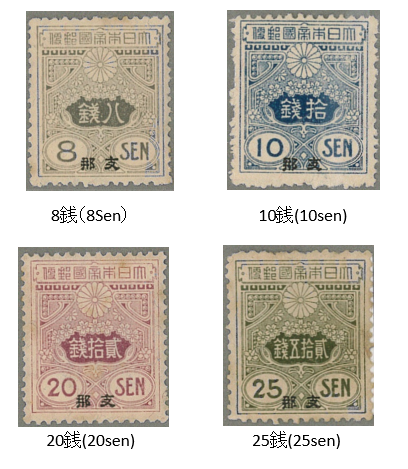
支那字入旧大正毛紙 3 1914-1919(大正3-8) 発行 1895年(明治28)に日本は日清戦争に勝利した。日本は、その後も中国本土に軍を駐留させ、民間人による現地経済活動を促進させた。1899年(明治32)11月、逓信省令により、1900年 1月から在韓国及び在支那(中国)で売り捌かれる切手は、「朝鮮」または「支那」の加刷をする こととなった。朝鮮字加刷切手は1901年に廃止されたが、支那字加刷切手は、日露戦争勝利 により満州南部の実質支配が行われた後も、中国での日本通貨の流通網達成が相当期間に 渡り困難だったため、1922年(大正11)まで使用された。1914年(大正3)、国内切手が、大正白紙切手から、透かしの入った大正毛紙切手に変わったため、支那字加刷切手も毛紙切手に変更され、1919年まで発行された。
China overprint Taisho Strained fiber paper 3 Issued on 1914-1919 (Taisho3-8)
In 1895 (Meiji 28), Japan won the Sino-Japanese War. Japan continued to station troops in mainland China to promote civilian local economic activity. In November 1899
(Meiji 32), by the Ordinance of the Ministry of Communications, stamps sold in Korea and China (China) from January 1900 will be overprinted with "Korea" or "China". Korean overprint stamps were abolished in 1901, but Chinese overprint stamps have been able to achieve the Japanese currency distribution network in China for a considerable period of time even after the real control of southern Manchuria was achieved by the victory of the Russo-Japanese War. It was used until 1922 (Taisho 11) because it was difficult to cross.
In 1914 (Taisho 3), domestic stamps changed from Taisho white paper stamps to strained fiber paper stamps, so Chinese overprint stamps were also changed to Taisho strained fiber paperstamps and were issued until 1919.
